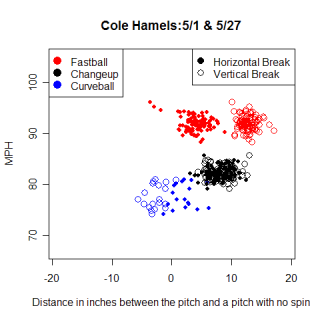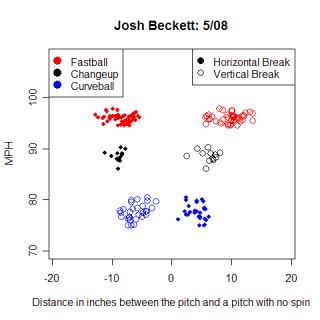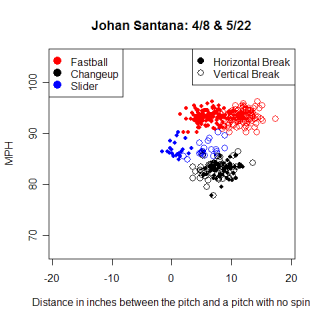
| Command Post | June 14, 2007 |
Cole Hamels is 100 feet tall, sky dives without a parachute and stars in movies about gladiators. He invented the Internet, knocked over the Berlin Wall with a changeup and struck out Andruw Jones three weeks before their first meeting this season. NASA has asked him to throw a probe to Mars, which he would do, except he already destroyed Mars (he used a fastball this time) after some Martians questioned his pitching ability. In his spare time Hamels pitches for the Phillies, and this season is leading the NL in wins and strikeouts. He is also among the league leaders in WHIP, walks/9 and strikeout/walk ratio. Hamels features one of the best changeups in the majors as his out pitch, but what makes this pitch so effective? How does his changeup continue to baffle hitters?
Hamels has had two starts tracked by Gameday this season, both of which were in Atlanta. Additionally, the starts both took place in May, once the system had been operational for several weeks, so any differences in positioning of the camera systems should be minimal. Looking at a chart showing Hamels' pitches, there are two possible reasons why his changeup is so nasty. The first is the speed difference. His median velocity on his fastball is 92 MPH compared with his 82 MPH changeup. That 10 MPH difference means that his changeup takes (very) roughly an extra .05 seconds to reach home. .05 seconds obviously isn't much time, but when the reaction times for hitters are in the range of .4 to .5 seconds, maybe .05 seconds means more. It could be the difference between just fouling off a pitch and hitting it squarely. However, without looking at other changeups, its impossible to say whether a 10 MPH difference between his fastball and changeup means anything.

The other feature of Hamels' changeup that jumps out at me is the movement. His fastball has about four inches of movement in to a left-handed hitter (positive horizontal values on these images represent movement toward a left-handed hitter, while negative means movement in the opposite direction). However, his changeup doesn't move in exactly the same way as his fastball. The changeup breaks in on left-handers more than his fastball does, and looking at the vertical movement relative to the fastball, you can see it has some sink on it as well. One way to pick out changeups when reading these graphs for most pitchers is to look for pitches that break similarly to the fastball, but are slower.
Here's an extreme example of a changeup that moves almost the same as a fastball. This chart for Josh Beckett is remarkable for the fact that there is absolutely no overlap in speeds between any of his pitches, but it also shows the similarity of his changeup to his fastball. (For a couple more examples of changeups that move the same as fastballs, check out the article I wrote on sinkerballers. One correction though, on the graphs for Lowe, Cook and Webb I mislabeled changeups as sliders, so the black dots are changeups, not sliders.)

Beckett and others have succeeded with changeups that mirror the movement of their fastballs, but that little extra movement that Hamels gets might make his pitch that much harder to hit. The difference between Beckett's fastball and changeup was seven MPH, which is close to Hamels'.
I wanted to compare Hamels to other pitchers with great changeups and the first name I thought of was Trevor Hoffman, the inspiration behind Hamels' changeup. Despite a fastball that tops out around 90 MPH, Hoffman is still fooling hitters. How is he doing it? Here's a chart showing Hoffman's pitches in his 17 appearances at Gameday equipped stadiums. All but two of the appearances were in San Diego, so the inter-park effects should be small here as well.

Hoffman's changeup appears to move like his fastball. However, upon closer inspection, you can see the changeup moves inside on a right-handed hitter almost four more inches more than his fastball does. In addition to the four inches of movement, Hoffman throws his changeup almost 12 MPH slower than his fastball. The added movement helps, but Hoffman's success primarily comes from his ability to upset a hitter's timing with his changeup. By showing a hitter the 76 MPH changeup, Hoffman is able to make his 88 MPH fastball seem much faster.
Hoffman and Hamels have never won a Cy Young (although in the future Hamels will win one Cy Young…and 11 Cole Hamels'.) but Johan Santana has ridden his changeup to two awards. Santana is similar to Hamels in that they are both left-handed, strike out a lot of hitters and don't walk many. How do their changeups compare though?

Here's a chart from Santana's starts on April 8 at Comiskey Park and May 22 at Texas. I looked at both starts separately before combining them and the pitch regions were similar in both ballparks. Santana's fastball is thrown around 93 MPH while his changeup is thrown at 83 MPH, giving him a difference of 10 MPH, the same as Hamels achieved in his starts. Santana also gets different movement on his changeup compared to his fastball, although the magnitude is smaller than the four inches that Hamels and Hoffman were able to achieve.
Name # thrown Speed Horizontal Break Vertical Break Hamels-FB 96 91.90 MPH 4.00" 12.69" Hamels-CH 83 82.20 MPH 7.81" 8.63" Hoffman-FB 119 87.90 MPH -0.20" 14.96" Hoffman-CH 70 76.00 MPH -3.84" 10.79" Santana-FB 116 93.35 MPH 6.02" 11.74" Santana-CH 58 83.30 MPH 8.47" 7.36"
This table shows the differences between the changeups and each pitcher’s fastball. Both types of pitches moved to the arm-side of a pitcher, but the for the same pitcher, changeups moved more than the fastballs did and also had less vertical break. Greg Maddux and James Shields both have good changeups and the table below shows the differences between them. There are very different ways to have effective changeups. Maddux has a five MPH difference between his fastball and changeup, but his changeup has less movement toward his arm-side than his fastball does. Without comparing any more pitchers, I’d venture to guess that Maddux’s movement is unique and has contributed to his success. Shields has been successful so far this season using a changeup. His changeup moves like Hamels’, Hoffman’s and Santana’s, but has less of a speed difference, so maybe the ideal speed difference between pitches is around 7-10 MPH.
Name # thrown Speed Horizontal Break Vertical Break Beckett-FB 48 96.10 MPH -8.19" 10.09" Beckett-CH 12 88.70 MPH -8.80" 6.40" Maddux-FB 194 86.60 MPH -10.01" 6.72" Maddux-CH 61 81.60 MPH -5.26" 6.87" Shields-FB 154 91.20 MPH -6.53" 10.31" Shields-CH 80 83.35 MPH -9.29" 4.78"
The changeup can be a very effective pitch if used properly. It seems that changeups tend to move more toward the arm-side of a pitcher and have less vertical break than that same pitcher’s fastball. This movement is one way to pick out changeups from the Gameday data. Pitcher’s with good changeups have different amounts of movement and velocity, so there are obviously multiple ways to be effective with the pitch and I think the most important factor in determining the success of a pitch is how it relates to the other pitches in a pitcher’s arsenal. However, Cole Hamels doesn't even need his changeup; he once struck a man out looking. Literally. Cole just gazed at him and the batter was retired on strikes.
I did all my research for this article at ColeHamelsFacts.com.
Comments
Minutes after winning his 500th straight MLB decision, Cole Hamels took the time to cure my son's lepracy.
On another note, I find the amount of sink on their fastballs to be startlingly high. I always thought Beckett's FB rode a lot more than that -apparently it sinks quite a bit.
Posted by: matty b at June 14, 2007 4:16 PM
It's hard to come up with more hyperbole than that. Brilliant.
Posted by: Rob McMillin at June 14, 2007 7:35 PM
If Hamels walks on water, how come the Tribe tattooed him last nite?
Posted by: James Rydzel at June 19, 2007 2:13 PM